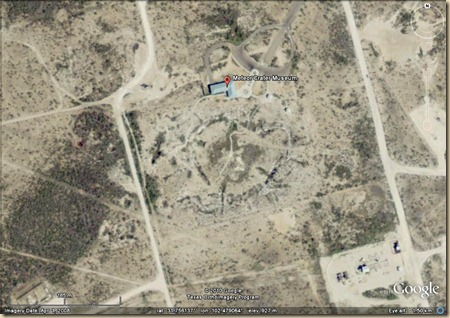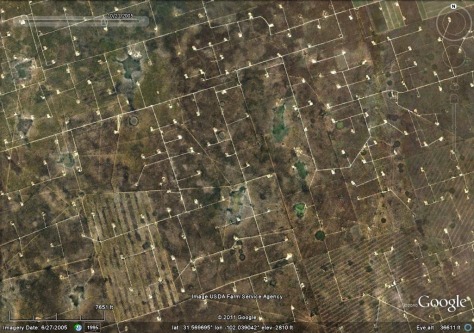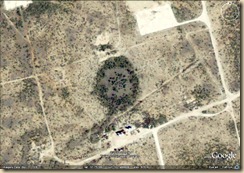The other day I was watching an episode of the ‘Meteorite Men’. It was the one in which they went to try their luck at the Odessa crater, in Texas. It was a good show. But the guys had a tough time of it.
Untold numbers of meteorite hunters, and collectors, who had worked that site before, have turned the ground over so much, they’ve picked that place clean over the years. It’s barely recognizable as an impact structure anymore.
Odessa Crater at 31.765137, –102.479064
Geoff, and Steve, worked that site every which way but loose. And they still came up empty handed…, almost.
It wasn’t until they gave up looking, packed up their gear, and started driving away disappointed, that the Meteorite Men found anything. On their way out of the area, in the gravel of the road, they spotted meteorite fragments lying right there in plain sight. So they stopped, took out their metal detectors, and started digging fragments. After giving up on a day of frustration, they made a pretty good haul, right there in the gravel of the road. And they left the area with some really nice Odessa Irons.
And then, as happy as can be, they just drove away, richer by a few nice meteorite fragments, (As a matter of fact, a few thousand dollars worth!) and a good episode for their show. But in the significance of where they found those fragments, they also drove away from what may be the single most important clue of their careers.
You see, when those dirt roads in that oil field were graded they hauled in aggregate to elevate the surface a few inches for better drainage. That aggregate did not come from inside the crater. It came from a location about 20 miles away. The mystery there was; since the dump truck that brought in that thin layer of aggregate got its load from a quarry miles away, how did all those Odessa Irons get into that load of aggregate for the road bed?
The answer, is that Odessa crater was not alone. In the world according to Google Earth, it is only one of many thousands in a vast cluster event. Scan the area of southeast New Mexico, and west Texas, carefully from an eye height of about 5 km. And you will quickly see that, scattered among the oil fields, there are too many craters like the Odessa structure to count.
In the image you see below, the white lines are dirt roads about 7, or 8, meters wide. And each of the clearings that show up as little rectangles of a half an acre, or so, are the location of an oil well pump.

I have heard that ‘most geologists agree’ that the Odessa event was about 60,000 years ago. I don’t believe that for a minute. I want to see proof. I’ve also heard estimates as young as 20,000 years. Until I see some radiometric data, I am working from the postulate that they are much younger than that. Less than 13,000 years old as a matter of fact. And they are all the same age. Give, or take a few seconds.
 This one is about 1,100 meters, west, southwest at 31.751892, -102.489898
This one is about 1,100 meters, west, southwest at 31.751892, -102.489898
The meteorite hunters, and collectors, want to keep the locations where they find meteorites a secret. So their collections retain their rarity, and value. Besides, if you have found a location where you can sometimes turn up a few thousand dollars, there is no incentive to tell the world where your pot-o-gold is.
If a collector has a lot of money invested in Odessa meteorites, then the news that the crater has thousands of sisters, in a vast crater field, and was part of a giant cluster event, (Odessa Irons are probably much more common than we thought!) May not be good financial news.
But the impact researchers want to catalogue every impact structure. So we can do an accurate, impact threat assessment. The fact that the Odessa object may have been only one of thousands in a huge cluster changes everything when you are trying to do threat assessment. And to come up with survival, and mitigation strategies.
There would be no way to turn a cluster of fragments such as that aside. And we are beginning to realize that there is nothing to indicate impact storms like that are rare. The one the hit the Southwest a few thousand years ago may have been the worst in 65 million years. But smaller ones that devastated tens of thousands of square miles on land, or generated giant impact Tsunamis, when they hit an ocean, seem to have been happening about 1,500 years apart for the past 20 or 30 thousand years. They come out of the Taurid meteor stream.
Most of them, even the ones that toppled civilizations, left no craters at all, only burnt, and blasted ground, and sometimes giant tsunami scars, or wind driven flows of flash melted stone. Nothing like what we thought a large impact event should do.
When big cluster events like that happen, the meek inherit the Earth. That’ll be the little critters hiding in holes. And the adaptable ones that can eat almost anything. And that don’t need much of what they do eat. Any survivors would have be a long ways away, in a deep hidey hole. The climate changes would be long term. For a while again, it would become an adapt, or die world.
Good impact threat assessment is a big deal if we want to know where, and how deep, to dig bunkers. And how long we’ve got to get them done.
And there are a few more Odessa craters in this Gallery



I saw that episode too and wondered why they never made an attempt to figure out where the road fill/gravel came from? It might of led to more and bigger finds. Something for a future chaser?
I hope they’ll go back. But if they don’t, someone will. We’re only looking at the tip of the iceberg there.
The simple empirical fact is that there are too many craters averaging 100 meters diameter to count in central Mexico, West Texas, and New Mexico.
And the most startling thing, is that they all appear to be exactly the same age. And they are all in almost pristine condition. It’s like they all fell in a giant cluster of fragments.
Look at Lubbock. The whole region is peppered with thes round holes…they are thought to maybe among other things buffalo wallows, or glacial remnants. The odd thing that at first thought that causes a problem is the similar size of all these structures. I will go along with the Odessa meteor Crater to be very old. But these too numerous to count structures are likely caused by non metalic impacts. Low mass objects that carry enough force to mark but not enough to cause a shocked crater structure.
I agree. I’m thinking they are a kind of airburst crater. Since they don’t have the morphology of a normal ballistic crater, the proof will be in the isotope mix. I would expect there to be significant siderophile, or platinum group, element inrichment.